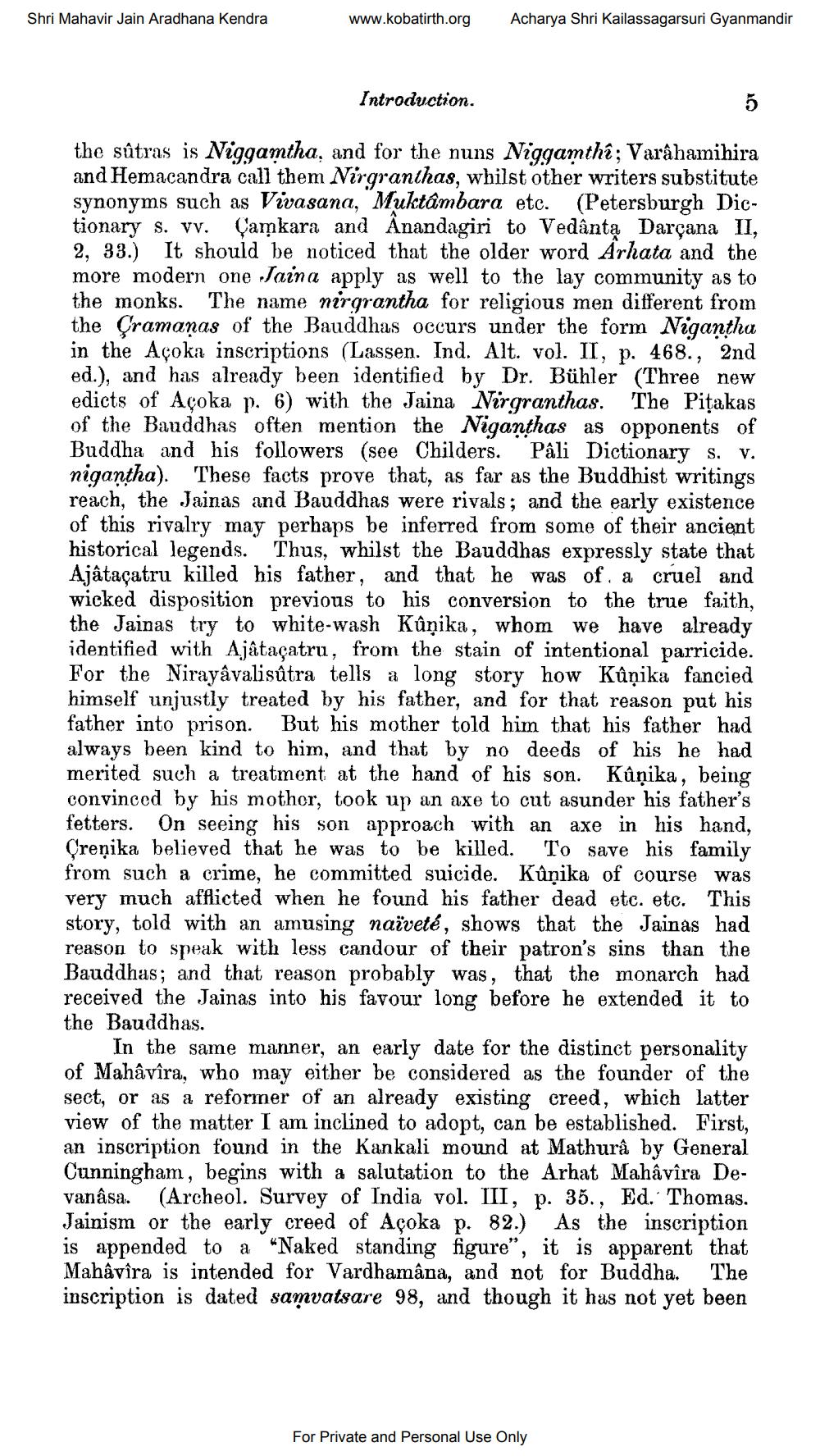________________
Shri Mahavir Jain Aradhana Kendra
www.kobatirth.org
Acharya Shri Kailassagarsuri Gyanmandir
Introduction.
the sûtras is Niggamtha, and for the nuns Niggamthê; Varâhamihira and Hemacandra call them Nirgranthas, whilst other writers substitute synonyms such as Vivasana, Muktâmbara etc. (Petersburgh Dictionary s. vv. Çamkara and Anandagiri to Vedânta Darcana II, 2, 33.) It should be noticed that the older word Arhata and the more modern one Jaina apply as well to the lay community as to the monks. The name nirgrantha for religious men different from the Cramaņas of the Bauddhas occurs under the form Nigantha in the Açoka inscriptions (Lassen. Ind. Alt. vol. II, p. 468., 2nd ed.), and has already been identified by Dr. Bühler (Three new edicts of Açoka p. 6) with the Jaina Nirgranthas. The Pițakas of the Bauddhas often mention the Niganthas as opponents of Buddha and his followers (see Childers. Pâli Dictionary s. v. nigantha). These facts prove that, as far as the Buddhist writings reach, the Jainas and Bauddhas were rivals; and the early existence of this rivalry may perhaps be inferred from some of their ancient historical legends. Thus, whilst the Bauddhas expressly state that Ajâtaçatru killed his father, and that he was of a cruel and wicked disposition previous to his conversion to the true faith, the Jainas try to white-wash Kûnika, whom we have already identified with Ajâtaçatru, from the stain of intentional parricide. For the Nirayâvalisútra tells a long story how Kûņika fancied himself unjustly treated by his father, and for that reason put his father into prison. But his mother told him that his father had always been kind to him, and that by no deeds of his he had merited such a treatment at the hand of his son. Kûņika, being convinced by his mother, took up an axe to cut asunder his father's fetters. On seeing his son approach with an axe in his hand, Creņika believed that he was to be killed. To save his family from such a crime, he committed suicide. Kûnika of course was very much afflicted when he found his father dead etc. etc. This story, told with an amusing naïveté, shows that the Jainas had reason to speak with less candour of their patron's sins than the Bauddhas; and that reason probably was, that the monarch had received the Jainas into his favour long before he extended it to the Bauddhas.
In the same manner, an early date for the distinct personality of Mahâvîra, who may either be considered as the founder of the sect, or as a reformer of an already existing creed, which latter view of the matter I am inclined to adopt, can be established. First, an inscription found in the Kankali mound at Mathurâ by General Cunningham, begins with a salutation to the Arhat Mahâvîra Devanâsa. (Archeol. Survey of India vol. III, p. 35., Ed. Thomas. Jainism or the early creed of Açoka p. 82.) As the inscription is appended to a "Naked standing figure", it is apparent that Mahâvîra is intended for Vardhamâna, and not for Buddha. The inscription is dated samvatsare 98, and though it has not yet been
For Private and Personal Use Only




